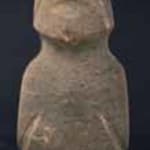Mezcala Stone Standing Figure, 300 BCE - 300 CE
Stone
3.75 x 10.5
PF.5291
An unusually pointed, conical head characterizes this figure. The indentations of the eyes, as horizontal ellipses, are placed very high on the head. A similar shape elliptical forms the mouth;...
An unusually pointed, conical head characterizes this figure. The indentations of the eyes, as horizontal ellipses, are placed very high on the head. A similar shape elliptical forms the mouth; with two deep slashes in a V-shape on either side, whose apex meets at the bridge of the nose stretching down just below the jaw line. This acute angle is repeated for the arms, which creates a pleasing contrast with the basic verticality of the figure. The legs are quite short in comparison with the body and are prong-shaped, as if intended to be stuck into the ground, or into holes designed for the purpose. When turned upside down, the standing figure becomes the face of a jaguar, perhaps symbolizing the powers of shaman to transform into wild creatures. The geometric style of the figure recalls the statues on Easter Island; and both may have had a similar purpose in depicting the human being as a god and the gods in human form.



